Our visit to Bikaner, India

by Amy
Posted on Monday, May 1st, 2006 at 7:51 pm CET
We spent two days in Bikaner, Rajasthan while visiting India in March 2006. Bikaner is a desert town with several interesting sights to occupy visitors. During our stay we visited the impressive fort, a camel research facility and a temple devoted to rats.
Getting there
We traveled from Jaipur to Bikaner on an overnight train. We shared a four berth AC compartment with two Indian gentlemen, one of which still have a very red face from playing Holi earlier in the day. The line from Jaipur to Bikaner is narrow gauge, which doesn’t make for a smooth ride. The train bounced around like a huge trampoline for most of the journey. We must have managed to doze a bit, because we both agreed the night passed rather quickly. I felt like I was awake the whole time though. It was hilariously, unbelievably bumpy. When I was lying awake I could hear the two Indians in our compartment snoring; they slept like logs. This was our first overnight train of two; luckily the second ride was in a broad-gauge train.
Our hotel
The Bhanwar Niwas Haveli was easily the best hotel we stayed in during our journey. Arthur wrote a really nice article about it, with photos.
The old city
Our haveli was located in the old part of town, within the city walls. The old city is full of small, winding roads which reminded us of Venice. It was very easy, and very pleasant, to get lost. Walking through the city, we saw many beautiful havelis, some crumbling from neglect.
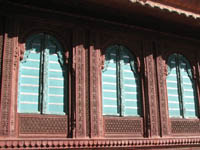
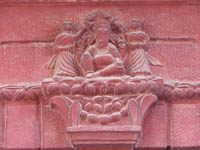
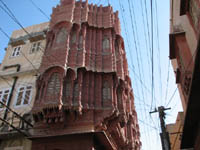
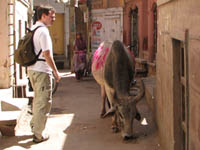
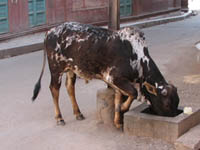
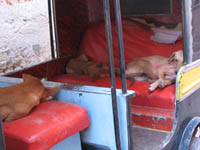
Old City of Bikaner
The National Research Centre on Camels
We hired a rickshaw to bring us to this camel research facility, about a 20-minute drive outside of town. Though it was outside official opening hours, we were allowed to have a brief tour of the facility, where we saw the different kinds of camels that are used as work animals in the Thar Desert. Though they were closed at the time of our visit, the center has a museum and shop where camel products are sold.
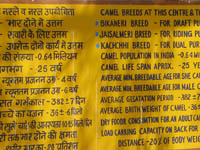
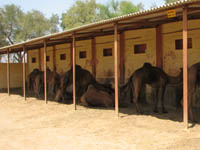
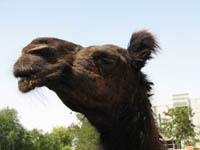
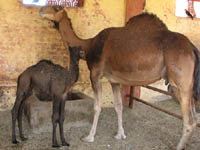
National Research Centre on Camels
Shopping at Abhivyakti
Back in Bikaner we stopped at a shop run by the rural charity the Urmul Trust. All of the products for sale are handcrafted by area villagers, and the profits go directly to the artisans. We had a friendly chat with the proprietor while looking over the merchandise. We bought a heavy cotton kurti, a shoulder bag, and an embroidered pillowcase.
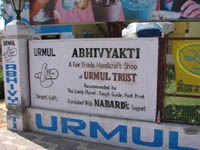
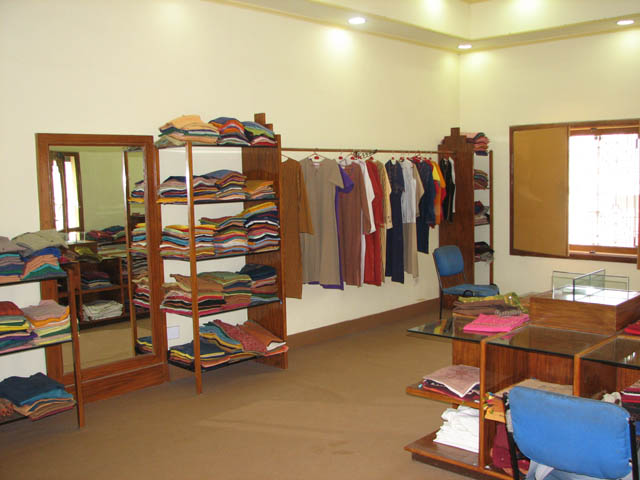
Abhivyakti
Junagarh, the fort of Bikaner
Construction on Junagarh Fort began in 1571. We toured the site with a guide, who took us to the many palaces, royal rooms museums within the fort. It was nice to have our own guide for a change; we saw a lot of details that I am sure we would have missed otherwise.
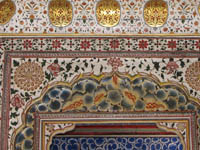
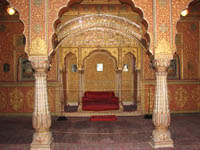
Elaborate decorations in Junagarh Fort
We learned a lot about the history of Bikaner and especially about their greatest maharaja, Maharaja Ganga Singh, who reigned from 1898 to 1944. He was a general in both world wars and was the only Indian present at the signing of the Treaty of Versailles. He brought the train, Ganga Canal, and other improvements to Bikaner and is remembered as a great leader.
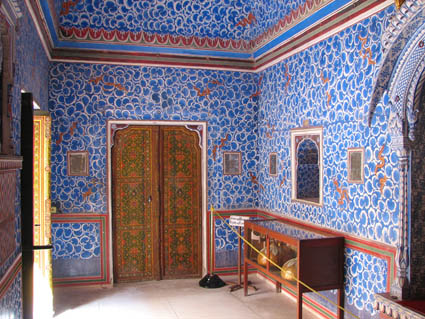
Cloud Palace in Junagarh FortThis palace, built by Maharaja Ganga Singh, is now run as a hotel. The defining feature of this lavish building was the huge amount of dead animals on the walls; it was a bit nauseating. The guide brought us to the hotel bar, where he pointed out stuffed deer, tigers, crocodiles and antelopes adorning the walls. We kept our heads down and said we didn’t much like to see all the dead animals. The guide then mentioned that he noticed a lot of tourists from Europe didn’t like to see the dead animals, but he wasn’t sure why. Our visit was cut short and we wonder if there were other wonders to behold at the hotel involving taxidermy.
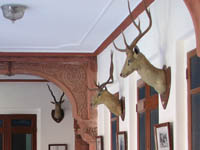
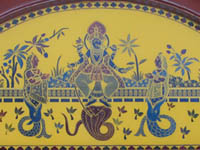
Lallgarh Palace, Bikaner
Besides the stuffed animals the public areas of the palace were quite lavish as you would expect. Our guide told us that the hotel rooms themselves, however, were quite plain. In fact, he knew of guests who cancelled their booking at the palace after having a tour of our haveli, in order to have a more lavish room there.
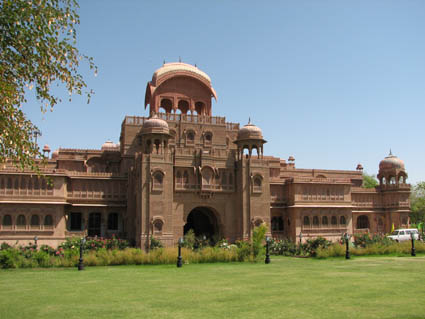
Lallgarh Palace, BikanerThe Rat Temple
We visisted the Karni Mata Temple, also known as The Rat Temple, which is located in Deshnok, close to Bikaner. You can read more about the temple here.
Bhandasar Jain Temple
The Bhandasar Jain Temple was built between 1468 and 1514. The interior walls were adorned with elaborate paintings, detailed engravings, and wild colors. The proprietor there seemed to be shooing birds away, which didn’t seem like a very Jain thing to be doing. We also thought we saw a mousetrap on the floor?!
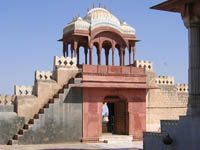
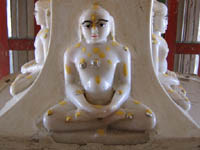
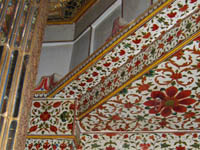
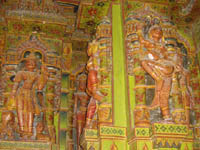
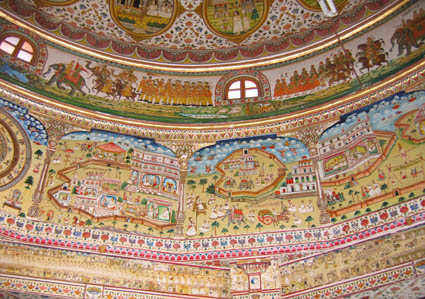
Bhandasar Jain Temple, BikanerWe enjoyed our visit to Bikaner and the sights it had to offer. Many tourists travel out to Jaisalmer for a desert experience but we chose Bikaner because it was less out of our way than Jaisalmer and because of its proximity to the Karni Mata temple.
We spent two days in Bikaner, Rajasthan while visiting India in March 2006. Bikaner is a desert town with several interesting sights to occupy visitors. During our stay we visited the impressive fort, a camel research facility and a temple devoted to rats.
Getting there
We traveled from Jaipur to Bikaner on an overnight train. We shared a four berth AC compartment with two Indian gentlemen, one of which still have a very red face from playing Holi earlier in the day. The line from Jaipur to Bikaner is narrow gauge, which doesn’t make for a smooth ride. The train bounced around like a huge trampoline for most of the journey. We must have managed to doze a bit, because we both agreed the night passed rather quickly. I felt like I was awake the whole time though. It was hilariously, unbelievably bumpy. When I was lying awake I could hear the two Indians in our compartment snoring; they slept like logs. This was our first overnight train of two; luckily the second ride was in a broad-gauge train.
Our hotel
The Bhanwar Niwas Haveli was easily the best hotel we stayed in during our journey. Arthur wrote a really nice article about it, with photos.
The old city
Our haveli was located in the old part of town, within the city walls. The old city is full of small, winding roads which reminded us of Venice. It was very easy, and very pleasant, to get lost. Walking through the city, we saw many beautiful havelis, some crumbling from neglect.
 |
 |
 |
 |
 |
 |
| Old City of Bikaner | |
The National Research Centre on Camels
We hired a rickshaw to bring us to this camel research facility, about a 20-minute drive outside of town. Though it was outside official opening hours, we were allowed to have a brief tour of the facility, where we saw the different kinds of camels that are used as work animals in the Thar Desert. Though they were closed at the time of our visit, the center has a museum and shop where camel products are sold.
 |
 |
 |
 |
| National Research Centre on Camels | |
Shopping at Abhivyakti
Back in Bikaner we stopped at a shop run by the rural charity the Urmul Trust. All of the products for sale are handcrafted by area villagers, and the profits go directly to the artisans. We had a friendly chat with the proprietor while looking over the merchandise. We bought a heavy cotton kurti, a shoulder bag, and an embroidered pillowcase.
 |
 |
| Abhivyakti | |
Junagarh, the fort of Bikaner
Construction on Junagarh Fort began in 1571. We toured the site with a guide, who took us to the many palaces, royal rooms museums within the fort. It was nice to have our own guide for a change; we saw a lot of details that I am sure we would have missed otherwise.
 |
 |
| Elaborate decorations in Junagarh Fort | |
We learned a lot about the history of Bikaner and especially about their greatest maharaja, Maharaja Ganga Singh, who reigned from 1898 to 1944. He was a general in both world wars and was the only Indian present at the signing of the Treaty of Versailles. He brought the train, Ganga Canal, and other improvements to Bikaner and is remembered as a great leader.

Cloud Palace in Junagarh Fort
This palace, built by Maharaja Ganga Singh, is now run as a hotel. The defining feature of this lavish building was the huge amount of dead animals on the walls; it was a bit nauseating. The guide brought us to the hotel bar, where he pointed out stuffed deer, tigers, crocodiles and antelopes adorning the walls. We kept our heads down and said we didn’t much like to see all the dead animals. The guide then mentioned that he noticed a lot of tourists from Europe didn’t like to see the dead animals, but he wasn’t sure why. Our visit was cut short and we wonder if there were other wonders to behold at the hotel involving taxidermy.
 |
 |
| Lallgarh Palace, Bikaner | |
Besides the stuffed animals the public areas of the palace were quite lavish as you would expect. Our guide told us that the hotel rooms themselves, however, were quite plain. In fact, he knew of guests who cancelled their booking at the palace after having a tour of our haveli, in order to have a more lavish room there.

Lallgarh Palace, Bikaner
The Rat Temple
We visisted the Karni Mata Temple, also known as The Rat Temple, which is located in Deshnok, close to Bikaner. You can read more about the temple here.
Bhandasar Jain Temple
The Bhandasar Jain Temple was built between 1468 and 1514. The interior walls were adorned with elaborate paintings, detailed engravings, and wild colors. The proprietor there seemed to be shooing birds away, which didn’t seem like a very Jain thing to be doing. We also thought we saw a mousetrap on the floor?!
 |
 |
 |
 |

Bhandasar Jain Temple, Bikaner
We enjoyed our visit to Bikaner and the sights it had to offer. Many tourists travel out to Jaisalmer for a desert experience but we chose Bikaner because it was less out of our way than Jaisalmer and because of its proximity to the Karni Mata temple.


2:14 pm
Rajasthan is famous for its jewellery industry and it is one of the world’s largest centre for hand-cutting of gems. It is India’s important source for precious and semi precious stones like; Ruby, Emerald, Garnets, Agate, Amethyst, Topaz, Lapis lazuli, Carnelian, etc. Rajasthan is known for the art of silver smithy, beginning from anklets to earrings to head gears.
Want to shopping in Rajasthan, No Problem we are here to arrange a tour for you and guide you for shopping.
For furthur assistance visit our website http://www.rajasthandiary.com